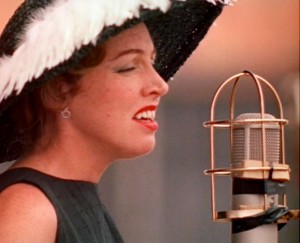Anita O’Day: Jezebel of Jazz or the Greatest White Female Jazz Vocalist Ever?
November 28, 2009
 Encountering Anita O’Day and delving deep in her recordings was, for me, a transformative experience. It was like the first time I heard Patsy Cline. I knew I was in the presence of a great talent. Then I read about her high life and hard times and my respect for her grew. She was the Keith Richards of jazz canaries. Click on image for larger size.
Encountering Anita O’Day and delving deep in her recordings was, for me, a transformative experience. It was like the first time I heard Patsy Cline. I knew I was in the presence of a great talent. Then I read about her high life and hard times and my respect for her grew. She was the Keith Richards of jazz canaries. Click on image for larger size.
Leaving home at 14, Anita spent her teenage years hustling (and singing a little) in the Depression-era dance marathons captured so magnificently in They Shoot Horses, Don’t They? The first phase of her career was as a songbird in Gene Krupa‘s big band beginning in 1941.
This association produced her first big hit Let Me Off Uptown. It was a novelty number with spoken dialogue between the young white female singer and jazz trumpet great Roy Eldridge, who happened to be black. “Well, c’mere Roy and get groovy!” she invites him, and introduces his solo by exhorting, “Well, blow Roy, blow!” Racy stuff for the 1940s. These were the war years and a more permissive stance in entertainment, and music especially, held sway. This jazz duo famously did not get along because Roy always felt Anita was upstaging him by dancing during his solos.
After Gene Krupa’s marijuana bust in 1943 Anita sang with Woody Herman and Stan Kenton. When Krupa reformed his band in 1945 Anita reunited with him for almost a year. In 1947 and gain in 1952 it was Anita’s turn to take marijuana possession busts.
In March of 1953 she was arrested for possession of heroin and did six months in jail. She and her long-time drummer John Poole, who introduced her to smack, were ‘hype buddies’ traveling the jazz club circuit across the country in the 50’s and 60’s, working diligently at the craft of jazz and just as diligently to score and maintain their mutual habit.
“We were spending 10 to 12 hours a day looking for it and playing games,” she writes in her autobiography, High Times, Hard Times. Note the long sleeved gloves in this 1963 concert appearance on Japanese TV.
It was during this period that Anita O’Day reinvented herself as a solo female vocalist. She recorded what many consider her best work for the Verve label between 1952 and 1962 and under the influence of heroin. Think Keith Richards during the Exile on Main Street sessions. She was also, at this time, Big in Japan, just like Tom Waits.
Dig the drum-and-vocal-only intro to Sweet Georgie Brown filmed by photographer and documentary filmmaker Bert Stern at the Newport Jazz Festival in 1958, released as Jazz on Summer’s Day (1960).
If this song doesn’t send you like it does me, brother, I can’t dig ya’ ’cause you must be dead.
After a near fatal OD in 1968 Anita cleaned up — by withdrawing on a Hawaiian beach — and became a fixture on the Jazz Festival circuit. Call this the third great phase of her career as she continued singing and recording into her late 80s. In 2006 she released a new album, Indestructible and finally left all of us cool cats and kittens behind when she died on November 23, 2006 at age 87.
Comments
Got something to say?
You must be logged in to post a comment.
